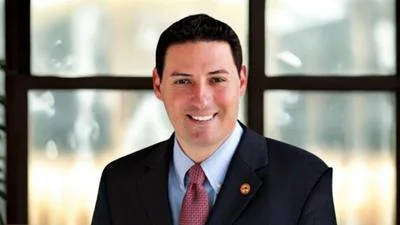Aprel Prunty, Alderman - Ward 6 | City of Rockford
Aprel Prunty, Alderman - Ward 6 | City of Rockford
City of Rockford Community Relations Commission met Sept. 12.
Here are the minutes provided by the commission:
I. CALL TO ORDER
Commissioner Todd Burton called the meeting to order at 5:30 p.m.
| Attendee Name | Organization | Title | Status | Arrived |
| Todd Burton | City of Rockford | Present | ||
| Eric Brown | City of Rockford | Present | ||
| Jurea Crudup | City of Rockford | Absent | ||
| Nikki Lynch | City of Rockford | Absent | ||
| William Martin | City of Rockford | Present | ||
| Norma Borrero | City of Rockford | Present | ||
| Mary Kaull | City of Rockford | Late | ||
| James McDowell | City of Rockford | Present | ||
| Joan Velazquez | City of Rockford | Late | ||
| Scott Garwick | City of Rockford | Present |
A. Journal of Proceedings for the Community Relations Committee meeting held on July 11, 2024
Commissioner William Martin moved to accept the Journal of Proceedings for the Community Relations Committee meeting held on July 11, 2024, seconded by Commissioner Scott Garwick.
B. Journal of Proceedings for the Community Relations Committee meeting held on August 8, 2024
Commissioner Martin moved to accept the Journal of Proceedings for the Community Relations Committee meeting held on August 8, 2024, seconded by Commissioner James McDowell.
III. INFORMATION ONLY
A. Panel Discussion on Sustainable Development & Upgrading Blighted Neighborhoods with:
i. City's Community & Economic Development Department
Jessica Anderson, Senior Neighborhood Stabilization Officer. Supervises code enforcement.
ii. City's Zoning Department
Scott Capovilla, Planning and Zoning Manager. Duties include long-range and short-term planning, Zoning Board of Appeals, Liquor and Tobacco Advisory Board, Historic Preservation, and Annexation Team.
iii. Home Builders Association
Not present.
iv. Rockford Community Investment Fund
Tom Sandquist, Executive Director. Located in the RLDC Office, but are a separate entity. A community development financial investment institution. Provides financing to individuals and small businesses to acquire and rehabilitate houses in the City of Rockford. Concentrates on the low and moderate income census track.
v. Urban Equity
Justin Fern, Founding Member of Urban Equity Properties in Rockford. Developers, contractors, and building owners in the downtown area creating a better city center.
vi. Zion
Bob Campbell, Executive Director of Zion Development Corporation. Works primarily in the midtown area, but has properties in various neighborhoods.
vii. R1 (Region One)
Eric Setter, Land Bank Coordinator. Council includes the Land Bank and the Winnebago County Trustee Program. Deal with taxable income, vacant properties and residential lots. Have worked with over a few hundred structures that have been sold and rehabilitated.
viii. GWA
Ashley Sarver, Principal and Urban Planner at Studio GWA. An Architecture and Urban Planning firm in Rockford. Involved in renovations as well as Downtown and Corridor Neighborhood Planning. Everything from commercial space to multi-family design.
Discussion
Manager Capovilla began the discussion. He stated that the Property Standards Team identifies properties in need of repair. Those owners who cannot afford repairs will turn to the Community Development Team for help in financing those repairs. One tool the city uses is its Vacant and Foreclosing Property Registry to track illegal dumping and disrepair. Another is the Stabilization Team using Knock and Talks.
Stabilization Officer Anderson added that the Knock and Talks were used to inform renters and property owners of the ordinances and to give them a chance to resolve any issue before writing any citations.
Legal Director Nicholas Meyer elaborated on what the Vacant and Foreclosing Property Registry is. The City Council passed an ordinance to create the registry. The ordinance requires that properties in foreclosure or voluntarily vacant be identified. This is done through either a citizen complaint or a vendor who identifies the property. Once determined that a property is vacant the vendor or a city staff member will notify the property owner that they are required to register the property and pay a small fee. The owner then needs to submit a plan on what the redevelopment and timeline would be. The owner will also be asked to allow an inspection to be done. If the owner does not allow that inspection, a warrant is obtained to complete the inspection and the city will then provide a timeline, through the code hearing process, on what the requirements are to fix up the property. The Registry has been successful in that some owners have actually listed and sold the property. There are developers in the market who have the ability, skill, wherewithal, and equity to fix these properties. Some owners don’t have that ability and need to be made aware of that. There is a balance between respecting property owner’s rights and respecting the rights of the community.
Ms. Sarver pointed out that a challenge to redevelopment is low property values. It has been recognized that property values have doubled but this is not consistent throughout the community. An example is of a property that sells for $20,000 but
needs $250,000 invested in it and eventually is only worth $70,000 in the end. The challenge is how to finance something like that because it is beyond the 80% value. There is an opportunity of these properties becoming rentals to make the investment worthwhile.
Mr. Fern clarified the discussion topic was how can we build more and affordable housing in our community quicker and more cost effective. The biggest issue would be the cost of construction which keeps rising. He recognized that the City is assisting development with the use of TIFs. He suggested to reevaluate the TIFs and to establish new ones. He suggested that there might be additional programs and additional forgivable loans to be used to offset these costs. Another recommendation would be to look at taxes. Rents offset high tax rates. This affects that amount of capital that needs to be raised to construct a building. Some cities have done tax freezes.
Mr. Fern also identified the length of the plan review process for building permits as an issue. The time to market adds to the cost of development. On larger projects, the length of 3 months triples the burn rate and losing up to 3 months of rent can increase that cost to 6 times. Looking at streamlining the plan review and building permit process would help to incentivize developers.
Commissioner Borrero asked what would be a better timeline?
Mr. Fern said that a 30-day, 45-day, or maybe 60-day clock would work on larger projects. He believes you used to be able to pay an extra fee to fast pace permits.
Manger Capovilla responded that was for small remodels and that it was no longer available.
Mr. Fern suggested that perhaps there could be a check list used to fast pace plan review and permitting. An example is the list could identify the size of the project and length of time the property has been vacant.
Commissioner McDowell commented that in the process all aspects of the plan have to reviewed and approved. He asked what is causing a three month disconnect in that process?
Mr. Fern thought there is a lot of back and forth between the architect or AOR and the City building staff and perhaps could figure out a way to speed that up.
Mr. Campbell added that he thought there could be streamlining done as well. He also agreed with Mr. Fern on taxes. He mentioned that the County chose to opt out of an incentive for owners of multifamily properties who fix up their property and rent a small percentage of them as affordable housing. They would get a reduction in their tax assessment. Both large and small landlords could benefit from this. The system has been in place in various parts of the state for years. The Cook County Assessor was willing to work with the county to implement the system.
Mr. Setter stated demand is incredible for properties the Land Bank has acquired, what 3 or four years ago would have been demolished immediately, are now getting to small developers to renovate. This grows the tax base.
Stabilization Officer Anderson thinks that demolitions are half of what they were last year at this time and those properties are going to the Land Bank.
Mr. Setter added that there is also the added savings of not doing the demolitions.
Manger Capovilla commented that the City is able chose properties that aren’t that bad and send them to the Land Bank. This saves a home and it becomes a taxable structure.
Mr. Sandquist said that the Investment Fund’s biggest problem is capital. Their capital is fully deployed or committed for and has been for the better part of the year. If they had the means they could have lent out more.
Mr. Campbell brought the conversation back to sustainable communities. Zion is proud of the environmental work it has done in rehabbing their buildings. However, they had a project to put in a Micro-Forest at Kishwaukee and 5th Avenue but has not able to because the census tract for the area was no longer considered an environmental justice area. Therefore, they were unable to qualify for those type grants for the project. The census tract for that location was not an environmental justice area when directly across the street was.
Chairman Burton asked for questions from the Commissioners.
Commissioner McDowell brought up the Commission’s pervious discussion on modular homes and the restrictions involved with them. Several meetings ago there were panelists who provided housing for homeless or in need people. Now the commission hears that there are properties available that are not being demolished. He asked if there was a way to get these panelists together to figure out how to get a better source for those properties?
Commissioner Martin noted that the majority of blighted properties are located in the South West and West sides of Rockford. When looking at affordable housing, the question is can people afford it? A property in the South West side sold for $50,000, was rehabbed, and resold for $160,000. House the eligibility income base for support programs is $44,000. This aligns with news reports about the crisis of individuals that will probably never be able to afford a home.
Mr. Campbell added that the struggle with affordable housing is that the funds are provided in relation to how the project disperses poverty. When applying for tax credits for low income housing, points are awarded based on where the development is located. The census tract around Rock Valley College awards the maximum points. The Midtown, West and South West sides are awarded zero points. The amount of points can make the difference if a project gets funded or not. Ideally affordable housing dollars should go to two things: one to dispersing poverty and the other toward fixing up homes in low-income housing. However generally that is not what you find. Developing affordable housing in a low income neighborhood is considered concentrating poverty. Developing in a middle-income neighborhood is thought to bring down property values, which studies show that is not what happens. Developing in a high-income neighborhood gets the same arguments and property owners have the means to fight the development. It is difficult to find a neighborhood that everyone agrees affordable housing should be developed in.
Chairman Burton asked who determines the scoring methodologies?
Mr. Campbell replied it is done state by state. The tax credit program is a Federal Program, but the tax credits are issued by the state.
Sarah Leys, Deputy Director of Community and Economic Development, expanded on the tax credits. There are two different kinds of tax credits. One is four percent and the other is nine percent. The nine percent credit is highly competitive and provides the least amount of gap in what has to be raised in private money. The four percent is a rolling credit that’s not competitive but the gap for private funding is greater. The four percent credit gives greater flexibility on where you can develop but still has restrictions, like rent restrictions.
Mr. Campbell added that the State has focused the nine percent projects on new construction and the four percent projects on rehab.
Michaela Harris, Contract and Grant Compliance Officer, commented that there are two buckets of affordable housing. Affordable housing for low income, like housing authorities, have certain caps on the income limits. Once the capped number of residents at the 80% AMI eligibility is reached, then the eligibility is lowered to 50% AMI. A large population of low-income individuals miss out on affordable, sustainable housing because they are over income. Affordable housing isn’t just about low income but the folks in the middle as well who can’t afford $1,200 or $1,300 rents but also don’t qualify for rent subsidy.
Mr. Campbell stated most of Zion’s tax credit projects are generally 60% AMI and below. However, their home ownership programs bump up to 80% AMI. On the rental side the AMI limits are a bit lower.
Chairman Burton thanked the panelists for their input and time. He directed if they had any further information they would like the Commission to consider to please direct that to Director Meyer.
IV. NEW BUSINESS
A. REGROW Presentation
Chairman Burton asked for an explanation of what the REGROW Grant is and what the Commissioners can expect.
Deputy Director Leys explained the purpose of the REGROW Grant and the process to award the grant. The grant is funded from the three percent tax assessed on the sales of cannabis. The grants are awarded to organizations that help individuals or address the causes in the public that have been negatively affected by cannabis in their community. This can be everything from youth intervention programs to housing programs. The City Council chose to award $500,000 in grants in three different funding amounts. Tier 1 includes ten (10) quick deployment grants of $10,000 each. Tier 1 grants are intended to fund immediate needs. Tier 2 will include four (4) grants of $50,000 and two (2) grants of $100,000. Applications will be submitted online this year. The portal will open on October 1st for the submission of the Tier 1 applications. The closing date for applications is on October 22nd. A review portal will be opened to the Commissioners on October 25th. At the November 14th meeting, the Commissioners will select ten (10) applicants to recommend to the Planning and Development Committee and refer them to the Committee at their November 5th meeting. The Planning and Development Committee will then refer the recommendations to City Council at its December 2nd meeting. The City Council will vote on the recommendations at their meeting. The awardees will be announced following the meeting. Tier 2 applications will be opened on November 12th. The grant portal is called Neighborly. The Commissioners will be offered a training for the grant review portal.
Commissioner Brown asked if part of the process will include applicant presentations before the Commission, as had been done in the past. Deputy Director Leys responded that it is the Commission’s process and can chose to do so. The timeline was only created to help move the process along. Tier 2 presentations can be added to the Commission’s January meeting if the Commissioners choose.
Commissioner Brown felt the presentations were helpful to have questions answered and show the passion of the project.
Chairman Burton mentioned professional grant writers.
Deputy Director Leys agreed by nature of the grant is to be awarded to grassroots applicants.
Commissioner Kaull asked how the Commission’s recommendations last year lined up with the Council’s approval.
Deputy Director Leys responded the Council accepted all of the Commission’s Tier 1 recommendations and added an additional $10,000 grant recipient. The Council accepted the recommendations for the Tier 2 grants.
Chairman Burton pointed out that the Council was very interested in the Commission’s process.
Commissioner Martin asked the Commission to consider the work being done by the grassroots organizations on the ground level to be able to help those communities. They may not have the assistance of a professional grant writer. He also asked what the process of recusal would be? Many of the Commissioners are part of organizations that may be applying. In the past it was difficult to get a quorum due to the recusals.
Director Meyer said there is discussion about appointing a subcommittee if there is a group of Commissioners who are not a part of any applicant organizations. He recognized many organizations are listed as partners to the applicant but those organizations are not aware of this. Will wait to see how many Commissioners are connected to an organization that is applying and if there is need to appoint a subcommittee.
Commissioner Brown asked if could get a list before the review portal is opened to verify who might have a conflict?
Director Meyer replied a list of applicants and partners could go out to
Commissioners for review.
Commissioner Velazquez inquired if there is anyone appointed in the City staff who is designated to provide guidance or answer general questions on the REGROW Grant application process.
Deputy Director Leys responded that last year there was a consultant available for the Tier 2 applications. If the Commission wanted to pursue this, then the Tier 2 timeline would have to be extended by a month or two to allow time for interaction with the applicants.
Commissioner Martin stated that he wanted to make sure the process is fair and transparent with a high level of integrity. If anyone contacted the Commissioners they could direct them to someone who could help. Therefore, everybody has a fair playing ground and the Commission can judge accordingly.
Commissioner Brown asked if there is a way to weight the scores if someone has a professional grant writer versus someone who is at the grassroots level?
Assistant City Attorney John Wuich responded that the City would not tell the Commissioners how to score. It is the Commissioners responsibility to make it part of their subjective scoring.
Commissioner McDowell inquired if there is a specific rubric to guide the process.
Chairman Burton recommended the Commission can walk through the rubric during a separate meeting.
Contracts and Grant Compliance Officer Harris will have it put on the October meeting agenda.
V. COMMISSIONER REPORTS
Commissioner Borrero reports that she is honored to be invited to the Fiestas Patrias to give the opening prayer. She was pleased to see the visibility of the Hispanic Community.
Commissioner Martin wants to thank Director Meyer, the Mayor and other City Officials for coming out to the dedication of the new mural by the artist collective “Fatherless” on the Guysie Jenkins Resource Center building in the 5th District. He stated it was one of the most beautiful murals in the city.
Chairman Burton noted that the City is holding two meetings on the Five-year Consolidated Plan on housing. They are on Wednesday September 18th and Tuesday September 24th. It is directly related to the work that the Commission does. He also mentioned an email he asked to be circulated to the Commissioners. The Center for American Progress is conducting a four-hour online seminar regarding Innovative Solutions to the U.S. Housing Crisis.
VI. ADJOURNMENT
1. Motion to Adjourn
Commissioner Martin moved to adjourn the meeting. The meeting was adjourned at 6:52 p.m.
http://rockfordcityil.iqm2.com/Citizens/FileOpen.aspx?Type=15&ID=2624&Inline=True





 Alerts Sign-up
Alerts Sign-up